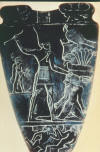|

*************************************************
Pyramids at Giza
The Great Pyramids were
built in the 4th Dynasty. The tallest one, in the
center, is the pyramid of Khafre built between 2520 and 2494
B.C. The pyramids of Khufu and Menkaure flank it.
"The immensity of the
Gizeh pyramids and that of Khufu in particular is indicated
by some dimensions. At the base, the length of one
side of Khufu's tomb is approximately 775 feet, and its area
is some 13 acres. Its present height is about four
hundred and thirty feet (originally four hundred and eighty
feet). The structure contains roughly 2.3 million
blocks of stone, each weighing an average of two and
one-half tons. Napoleon's scholars calculated that the
blocks in the three great pyramids were sufficient to build
a wall one foot wide and ten feet high around France."
- Gardner's
Art Through The Ages,
11th edition, Vol. I, pp. 52 - 53

**************************************************
Sphinx and Pyramids at Giza
The famous Sphinx seems to
originally have been intended as a guardian for the pyramid
of Khafre (seen in the background with a bit of the
limestone facing remaining). The Sphinx is, for the
most part, actually carved, not constructed, from a rock
protrusion. Most likely the face is a depiction of
Khafre himself.

*****************************************************

King Narmer's Palette
"In
Pre-dynastic times, Egypt was divided geographically and
politically into Upper Egypt, which was dry, rocky, and
culturally rustic, and Lower (northern) Egypt, which was
opulent, urban, and populous. The ancient Egyptians
began the history of their kingdom with the unification of
the two lands. Until recently this was thought to have
occurred during the rule of the first dynasty pharaoh Menes,
identified by many scholars with King Narmer. Narmer's
image and name appear on both sides of a ceremonial palette
found at heirakonpolis. The palette is one of the
earliest historical (versus pre-historical) artworks
preserved. Although it is no longer regarded as
commemorating the foundation of the first of Egypt's
thirty-one dynasties around 2920 B.C. (the last ended in 332
B.C.), it does record the unification of Upper and Lower
Egypt at the very end of the Pre-Dynastic Period." - Gardner's
Art Through The Ages,
11th edition, Vol. I, pp. 45 - 46
|